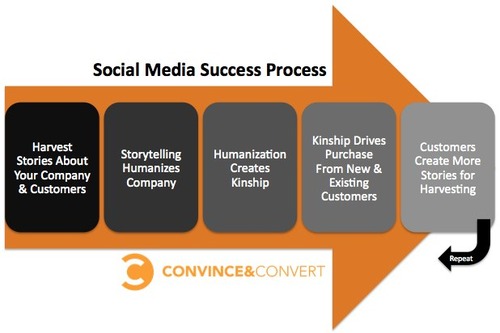Storytelling Humanizes

Social Media Success Process (graphic via Ripple100)
This graphic grabbed me. Irritated me. Fascinated me. Lead me to the Significant Objects Project… Eureka!
Let’s start with the grabbing. The graphic is titled, “Social Media Success Process” not “Process by which social media CAN drive increased market share.” There’s an implicit confidence, an assertion that collecting and sharing stories help a company. That humanizing a corporate entity through storytelling is beneficial. Amazing! Not everyone sees it that way. Some worry about the stories. Not the good ones. The other ones. Some worry about the loss of control. The potential damage to a brand. Of course, the near ubiquity of social media has changed so much for big corporations, not the least of which is that they can’t control and spin their message the way they once could. The consumer can access and share information readily, freely, easily, often. It’s easy enough to come up with the risk to companies today. Better play fair! But it’s even more intriguing to consider that stories of all sorts serve to humanize companies and therefore contribute kinship, community, value.
So, what irritated me? Perhaps this same confidence, er, hubris. Maybe it’s that third step: “Humanization Creates Kinship“. Sometimes it does. Sometimes it doesn’t. Sometimes it reinforces bias, distinctions, tribalism. Unless the stories are being curated carefully, thoughtfully, continually. But that’s not really the problem either, because I actually do believe that open storytelling will lead to open corporate culture which will lead to corporate consumables that have nothing to hide and nothing to spin. Some bumps and bruises might be incurred during the transition to this ideal model, but I’m confident it will happen. So maybe it makes sense to say that kinship will follow humanization, but it will be organic and gradual if storytelling and story sharing is truly open. Which leads me to the principle irritant: harvesting. In a model where we’re talking about humanizing a company, it is disingenuous to speak about harvesting stories. You harvest corn. Or apples. You don’t harvest people’s lives, people’s experiences, people’s memories, people’s emotions, people’s emotions, people’s stories. That would be dehumanizing. Make sense?
My fascination has already revealed itself. Stories and storytelling – at best – are not formulaic. Sure, we all learned the basic ingredients for a well crafted story as school children, but good stories invite us into an un-formulaic relationship with another person. Good storytelling is personal, authentic, intriguing, original. Good storytelling builds a unique bridge between story creator and audience. This is why we trust the storyteller, why we WANT to trust the storyteller. So it fascinates me to see this corporate storytelling model reduced to a tidy flow chart. A formula. Fascinates me largely because I think it is pretty accurate!
It lead me to writer and New York Times columnist Rob Walker, and the Significant Objects project. But first, let me connect a few dots. I got hooked up with Ripple100’s Andre Yap (@andreayap) a day or two ago in the magical jungles of Twitterlandia. Turns out we’re both story traffickers, albeit of slightly different stripes. This graphic was the top story on his blog, a good read if you’re a storytelling wonk, and after a little poking around while ruminating on the graphic, I learned about Rob Walker.
“Here is what Rob did. He purchased a bunch of random objects on Ebay. He then distributed the objects to his friends, asked them to write a short story about each. He then put the objects back up for sale on ebay, essentially sold $120 worth of objects for $3,612 – a 2,776% significance markup as he calls it. All based on stories.“(Ripple100)
Wow! That’s right. He turned $120 worth of knickknacks into $3,612 by adding a story to each auction item. Genius. Or is it? Maybe it’s just real world proof of what we already know. We love stories. Whether we realize it or not, part of our human nature is an appetite, possibly even a need for storytelling. And yet, it is difficult to put a value on stories. A book? Sure. A movie? Sure. A song? Sure. A short story published in a magazine. Sure. But in each of those cases, the value of the story gets muddled with the value of the storytelling vehicle.
“What is the actual value of a story? Are people prepared to pay more for something if there is a story attached to it? It turns out that they are. That is the outcome of a very original experiment by writer / NYT columnist Rob Walker… So people were prepared to pay a lot more than the initial value of the storyless object. In fact the difference was so big that Rob concluded that the real value was in the story – the object was merely the vehicle for the story.” (DoubleThink)
So it would seem that the value of each story was the difference between the original price of the object and the final price paid for the object and the story. You can review the experimental data, but it only tells part of the story. Remember that the storytellers intentionally or inadvertantly promoted the experiment, as did the organizers, bidders, etc. In other words, the experiment developed a story of its own. So not only were the objects vehicles for stories, but the entire project became a metastory. It bridged people, connecting them, creating meaning, memories, emotions. In short, the items, the storytellers and the project organizers were “humanized” by virtue of telling stories and weaving others into those stories. Or am I pushing the formula too far? You decide.
“What are people really buying? … There are no easy patterns to sort of say, like, well, this is exactly the answer… Every single object sold for more than we paid for it… The project itself became a story and what, in some ways, people were buying was a souvenier of this experiment.” (Rob Walker)


